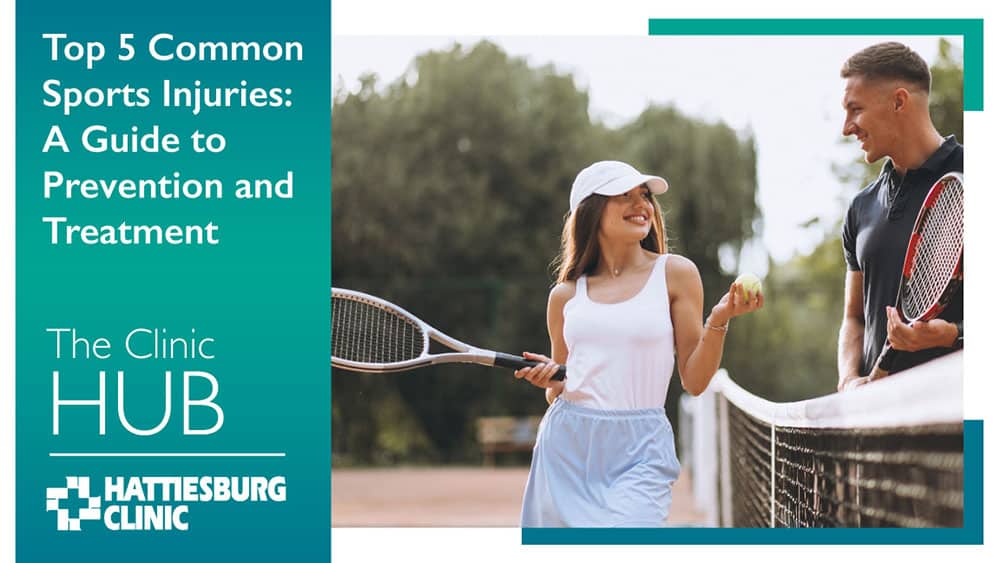Top 5 Common Sports Injuries: A Guide to Prevention and Treatment
Participating in sports is a great way to stay active and healthy, but it comes with increased risks of injury. Athletes, for instance, are no stranger to sustaining injuries. In fact, studies show that more than 3.5 million children ages 14 and younger get hurt annually playing sports or participating in recreational activities.1 From sprains to fractures, they are vulnerable to many types of injuries that can sideline them from their favorite activities.
“Any sport or activity can lead to an injury. Sports with more playing time or more participants, for example, can lead to a higher likelihood of an injury. A particular sport may predispose a participant to specific types of injuries,” explains Jeremy Wells, MD, a physician with Hattiesburg Clinic Orthopaedics & Sports Medicine.
Understanding the diverse risks associated with different sports is essential for athletes and their caregivers alike. According to Wells, “Football sees more concussions, sprains and fractures, while running often leads to stress fractures. Tennis and golf can lead to tendinitis, while basketball is often associated with ankle sprains and knee injuries. Gymnastics, on the other hand, may result in spine stress fractures. Baseball and softball are prone to shoulder and elbow injuries. Age also factors in, with younger athletes at higher risk for growth plate injuries.”
Understanding these common sports injuries, along with prevention strategies and treatment options, is critical for athletes of all ages. In this guide, we will cover the top five common sports injuries, providing insights into how to avoid them and what to do if they occur.
Sprains and Strains
Often referred to as a “minor” injury, sprains and strains stand out as a leading cause of sidelining athletes. A sprain occurs when a ligament is stretched or torn, while a strain involves damage to muscles or tendons. These injuries often result from sudden movements, overdoing it or improper technique. Common sites for sprains and strains include the ankles, knees, elbows (i.e., tennis elbows) and wrists. Ankle sprains – often referred to as a “turned ankle” – is one of the most common sports injuries.
Prevention: It is important to warm-up and stretch before physical activity to prevent sprains and strains. By doing this, you increase flexibility and improve blood flow to the muscles. Moreover, wearing supportive footwear and using protective gear — such as ankle braces, knee braces or wrist wraps — can reduce the risk of injury.
Treatment: Strains and sprains are generally treated by following the R.I.C.E. approach, which involves rest, ice, compression and evaluation.2 Over-the-counter pain medications such as ibuprofen (Advil, others) and acetaminophen (Tylenol, others) can also be helpful when trying to reduce pain.
Shoulder Injuries
A common hot spot for sport injuries occurs in the shoulders. Tennis and baseball/softball, for example, require repetitive motions in the overhead position and place a significant strain on the shoulder joints and muscles. Common shoulder injuries include rotator cuff tears, frozen shoulder, tendonitis and shoulder bursitis.
Prevention: A good tip for preventing shoulder injuries is to prioritize strengthening and conditioning exercises that aim to improve stability and flexibility in the shoulder joint. Additionally, athletes should pay special attention to maintaining good posture and technique during sports activities to reduce stress on the shoulders.
Treatment: Treatment for shoulder injuries typically involves rest, ice and anti-inflammatory medications to reduce pain and inflammation. Sports medicine specialists will coordinate care with physical therapists and/or athletic trainers to implement exercises aimed at strengthening the muscles surrounding the shoulder joint. In severe cases, surgery may be necessary to repair damaged tissues.
Knee Injuries
The knee is highly susceptible to injury during sports activities. Common knee injuries include fractures, ligament tears, meniscus tears, patellar tendonitis, knee dislocation and bursitis. These injuries often occur due to sudden changes in direction, twisting of the knee or high impact.3 Tears of the anterior cruciate ligament (ACL) and meniscus are among the prevalent sports injuries that impact the knee.
Prevention: Similar to other methods, knee injuries can be prevented by stretching or “warming up” your joints and muscles prior physical activity. Athletes should also take precautions to avoid sudden jarring movements and prioritize building strength in the hips and thighs to provide better support. Wearing proper protective gear, such as knee braces and supportive shoes, also offers additional support.
Treatment: Treatment for knee injuries varies depending on the severity and type of injury but may include rest, physical therapy, bracing and in some cases, surgery. Rehabilitation is necessary for restoring strength and range of motion to the knee joint.
Shin Splints
Shin splints are a common overuse injury that affects the muscles and tendons along the shinbone (tibia). This often appears in athletes who participate in activities that involve repetitive impact, such as running and jumping. Shin splints can cause pain and discomfort along the front or inner part of the lower leg.
Prevention: One of the best ways to prevent shin splints is to gradually increase the intensity and duration of exercise. Avoid overdoing it and analyze your technique, especially when running. Your body’s muscles and tendons need to adapt to the strain they are under during physical activity. Additionally, consider wearing footwear that provide good arch support and adding shock-absorbing insoles.
Treatment: Rest is the best way to treat shin splints. Continued activity can make symptoms worse, as well as delay recovery. Utilizing ice packs and nonsteroidal anti-inflammatory drugs (NSAIDs) may help reduce pain and inflammation. Additionally, stretching and strengthening exercises for the calf muscles help with a speedy recovery.
Concussions
Concussions are a mild traumatic brain injury that can occur as a result of a blow to the head or sudden jolt to the body. Sports such as football and soccer carry a higher risk of concussions due to the physical nature of the game. Often short term, symptoms of a concussion may include headache, dizziness, nausea and confusion.
Prevention: Properly fitting helmets and protective headgear can help reduce the risk of concussions in contact sports. As many as seven in 10 young athletes with a possible concussion report playing with concussion symptoms.4 Therefore, athletes should also be educated about the signs and symptoms of concussion and encouraged to report any head injuries immediately.
Treatment: When someone experiences a concussion, rest is the best medicine. Athletes diagnosed with a concussion should avoid physical activity and mental stimulation to allow the brain to heal until symptoms resolve. In severe cases, medical intervention and rehabilitation may be necessary to manage symptoms and prevent long term complications.
Due to the heightened incidence of injuries in contact sports, Hattiesburg Clinic offers the convenience of Friday night clinics during football season from 7:30 p.m. to 10:30 p.m.5 The initial physician visit is free of charge, and follow-up visits, X-rays and supplies are billed as customary.5
Our Expert Team is Here to Help
Whether you’re recovering from a sports injury like a concussion or seeking preventive measures to keep you in the game, our expert team is here to support you. Our sports medicine physicians are focused on providing personalized care, evidence-based treatment and comprehensive services to address your needs.
For more information, visit https://www.hattiesburgclinic.com/sports-medicine/.
###
Resources:
1: John Hopkins Medicine – Sports Injury Statistics

